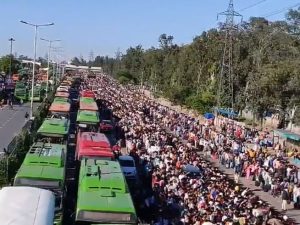 By Nageshwar Patnaik in Bhubaneswar, May 7, 2020: The tragedy of life is not that it ends so soon, but that we wait so long to begin it. The nationwide lockdown 3.0 by two more weeks till May 17 in India threatens to turn into a tragedy. Will there be a lockdown 4.0 and lockdown 5.0 in the future? When will it end completely? What is the exit strategy from lockdown 3.0? These are the questions confronting one and all.
By Nageshwar Patnaik in Bhubaneswar, May 7, 2020: The tragedy of life is not that it ends so soon, but that we wait so long to begin it. The nationwide lockdown 3.0 by two more weeks till May 17 in India threatens to turn into a tragedy. Will there be a lockdown 4.0 and lockdown 5.0 in the future? When will it end completely? What is the exit strategy from lockdown 3.0? These are the questions confronting one and all.
Moreover, the Narendra Modi government has not explained the rationale behind the third extension of the lockdown nor has it spelled out its purpose, objective and the overall strategy to contain the spread of the COVID-19 pandemic. The Government extended the lockdown by merely issuing an order. Neither Modi nor the Home Minister, Amit Shah spoke to the country about the extension of the lockdown. History will be the better judge of this decision.
The latest order of the Indian government divides the country into three zones-red, orange and green. The red zone which has a large number of COVID-19 cases will have total lockdown, the orange zone which has less will have some restrictions removed, while the green zone which has very few or no cases will have still fewer restrictions.
Many think that the zoning cannot be enforced strictly in practice. Majuscule section of the Indian workforce about 45 crore people is in the unorganised sector of our economy. These are daily wagers, migrant labourers, etc who earn their livelihood by working every day.
The 40-day long lockdown has already deprived them of their livelihood. Last month, media was agog with reports of gathering of tens of  thousands of migrant workers in cities desperately wanting to leave for their villages. Some even started trekking on foot with their families to their villages hundreds of kilometres away, as there were no trains or buses running. Many died on the way.
thousands of migrant workers in cities desperately wanting to leave for their villages. Some even started trekking on foot with their families to their villages hundreds of kilometres away, as there were no trains or buses running. Many died on the way.
In a recent article, Justice Markandey Katju, former Judge, Supreme Court of India and former Chairman, Press Council of India, observed, “I am afraid if this lockdown is not immediately lifted, there will soon be food riots due to large scale starvation, and consequential civil disorders. Thousands may die of corona if there is no lockdown, but millions will surely die of starvation if there is a long lockdown”.
Over 34 lakh people have been infected worldwide by the coronavirus and about 2.5 lakh people have died from the respiratory disease Covid-19. India has so far lost more than 1300 persons to Covid-19. According to Union Health Ministry’s latest figures, the number of active cases in India are 28,046. About 10,632 have been cured or discharged. Even with a 40-day lockdown, we are struggling to control the virus.
 The pandemic already has caused the largest industrial shutdown since the Second World War. The developed countries are likely to post a negative growth rate of around 6 per cent due to the ‘Great Lockdown’ recession, as the IMF calls it. The worst ever global recession since the Great Depression of the 1930s is staring the world.
The pandemic already has caused the largest industrial shutdown since the Second World War. The developed countries are likely to post a negative growth rate of around 6 per cent due to the ‘Great Lockdown’ recession, as the IMF calls it. The worst ever global recession since the Great Depression of the 1930s is staring the world.
What is worrisome most is that around 26.5 crore people in low and middle-income countries could face starvation by the end of 2020, according to the World Food Programme (WFP). No one can think of this happening in the 21st century, with all state-of-art technology at our command. This itself is a colossal human tragedy and a disgrace on the whole world.
The COVID-19 has already cost the Indian economy an estimated Rs 2 lakh crore a week. Two of the economy’s three large sectors, services and manufacturing are shut. They comprise 70.6 per cent of Gross Domestic Product (GDP) and employ 43.9 per cent of the workforce.
The government should waste no time to kick start the moribund economy. The process has begun, with the home ministry issuing guidelines allowing agricultural and MSME operations, transportation of goods without distinction and resumption of manufacturing in industries with access control.
Luckily, the most important engine of our economy, agriculture, is in a good shape. Agri-sector employs over half of India’s total workforce, but its share at just 17 per cent to GDP is the lowest among all sectors. But this sector will also be further under stress after the return of migrant labourers to their native villages.
 A bumper harvest this year – i.e six per cent higher than last year’s harvest is the only hope for a much-needed economic revival. In such a tragic situation that we are in, this year’s harvest is a windfall because it will propel an estimated Rs 8 lakh crore – i.e 4 per cent of GDP, into the shattered economy facilitating its revival.
A bumper harvest this year – i.e six per cent higher than last year’s harvest is the only hope for a much-needed economic revival. In such a tragic situation that we are in, this year’s harvest is a windfall because it will propel an estimated Rs 8 lakh crore – i.e 4 per cent of GDP, into the shattered economy facilitating its revival.
The Modi government has not yet announced a significant economic stimulus package. The only initiative thus far is the Rs 1.7 lakh crore package announced by the Finance Minister under Pradhan Mantri Garib Kalyan Yojana on March 26 which is just 0.7 per cent of the country’s GDP.
The government will announce a substantial stimulus package in a day or two. But it must address the plight of the working class and provide meaningful support to an already distressed agriculture, which now faces the additional burden of reverse migration.
It is a terrible thing to see a disaster in the making and be unable to prevent it. Yet this is the prospect confronting us at the moment. No one is disputing the necessity of the lockdown. But the government has the onerous responsibility of balancing lives with livelihoods. The country’s 27 crore or 21 per cent of population are below the poverty line and will become down and out if the lockdown continues endlessly.



Leave a Reply
Be the First to Comment!